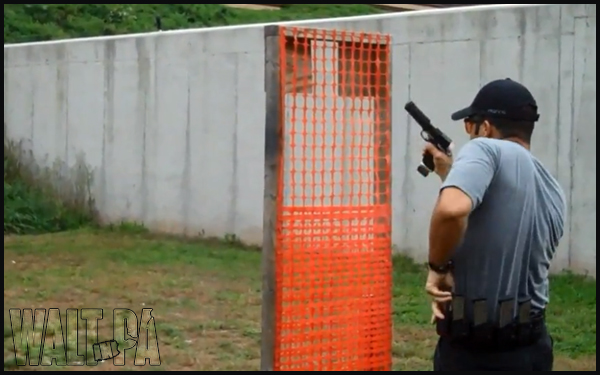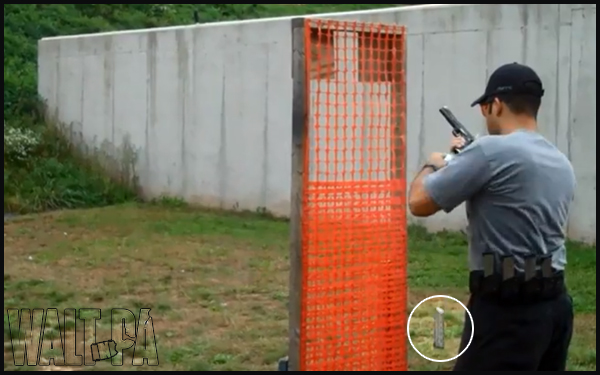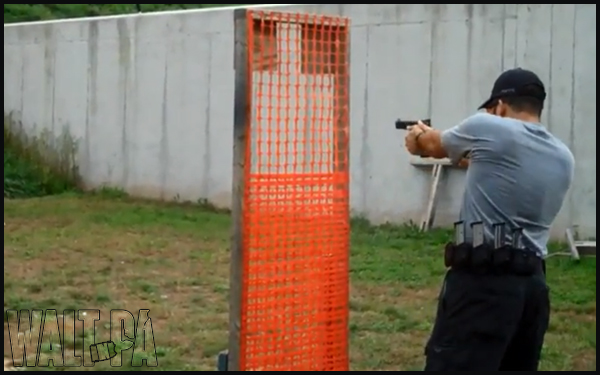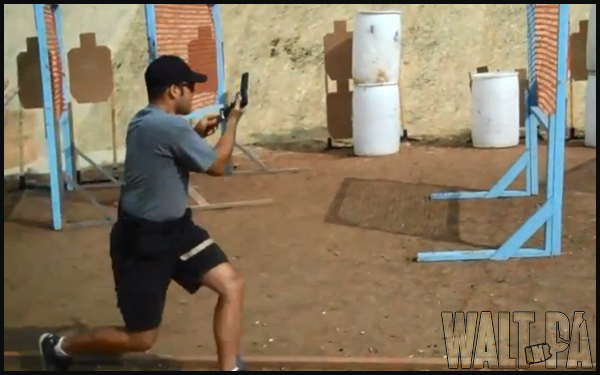There is a saying in USPSA that goes something like “If you’re moving, you’re reloading”. On the surface it doesn’t sound like much, but trust me, if you shoot USPSA you probably take that saying to heart. A standing reload is something all shooters avoid like the plague.
In a sport that revolves around speed and accuracy, a standing reload could mean the difference between 1st place and 5th place. As a result, shooters in Production, Limited 10, Single Stack, and Revolver divisions need to be proficient if they wish to excel.
A Stage that Makes a Point:
For the sake of making a point, I want you to envision a stage. The shooting area is roughly 8 feet by 8 feet and a series of obstacles block your field of view. Down range we have 16 targets totaling 32 rounds. Since USPSA Stages should not allow a shooter to see more than 8 shots from a given location, we are going to assume 3 reloads for limited capacity semi-auto divisions.
To extend this fantasy stage a bit further, let’s say that the average shooter can reload their gun in a timeframe of 3 seconds. Since the shooting area is so small, those reloads will be performed in a mostly-static position. At 3 seconds per reload, reloading 3 times, the average shooter is looking at about 9 seconds.
While 9 seconds may not sound like much, when you start calculating that time into a Hit Factor, it could easily cost you in the rankings.
Keeping Pace:
Whenever I go to a match, I try to pick a person in my squad to keep pace with. Sometimes it is someone in my division and sometimes it is someone that simply impresses me. One of those individuals that impresses me is Steve Lockwood. Even though Steve shoots in a different division, he has impressive reloads and does a good job of maximizing movement.
A good example of Steve’s reload can be seen on the 3-V Classifier Stage at Lower Providence Rod and Gun Club. While I’m not able to see Steve’s time on the shot timer, it looks like it takes place in roughly 1.5 seconds.

Drops the magazine while reaching for a fresh one

New magazine is in the gun before the old one hits the ground

By the time the old magazine hits the ground, Steve is back on target
Structure of the Reload:
A few minutes spent on Google could easily result in a dozen different ways to properly reload a gun. Some feel as though the gun should be low to prevent the muzzle from pointing in an unsafe direction. Others, like myself, want the gun up nice and high so that here is no transition between looking down at the gun and back up to the targets.
Right or wrong, the method that I subscribe to works for me. The only spin that I put on it is that I try not to look at the magazine well as I insert a fresh magazine. Ideally, I’d like to have the gun up high enough that it is in my field of view, however, I don’t want to focus on it. Instead, I use the semi-blurry vision to help drive the magazine home while I stay focused on the next target or position.

Gun is high, eyes focused on the magazine well, and hips square to the next position.
Practice is Key:
This summer has been rather hectic and as a result, I haven’t gotten in nearly as much practice as I would have liked. It has taught me the cold, hard lesson that shooting is a skill that depreciates with neglect. At the start of the season I woud dry-fire three times per week with a routine of 125 draws. Of those draw strokes, between 25 and 50 would incorporate a reload.
At one time my reloads were sharp. These days my reloads can be sloppy as I keep the gun low or miss the magazine well on the first try. The only thing that will correct that issue is additional gun handling. I have a lot of work ahead of me this USPSA off-season.
Ask The Readers:
How fast is your average reload and do you have a practice routine?
4 thoughts on “Studying the Reload: A Look at Steve Lockwood”
Comments are closed.
Recent Posts
From Group Ride Roasts to Real Life: My YouTube Channel Update
Well, my lovelies (I realize that sounds weird but at this point I need to lean into it), it's time for some real talk about where I've been and what's been happening behind the scenes at Walt in...
Reconnecting with friends, exploring scenic Pennsylvania back roads, and enjoying the simple pleasure of two wheels Getting the Band Back Together Today was a pretty special day in the...

I never thought reloading would be that much of a factor during these matches. You made some good tips about how to effectively reload & practice does make perfect (or as close to it as possible).
Shawn,
Reloading plays a big role in limited capacity divisions. I try not to run the gun dry (go into slide-lock) unless I absolutely have to (or screw up). There are times when I may engage 2-3 targets then reload, dropping 4-6 rounds onto the ground, because it is more efficient.
I haven’t had the opportunity to time my reloads, so I went on my Youtube channel. There are only a few videos where I change mags, so this is a small sample, but probably indicative of my skill overall.
On this video http://www.youtube.com/watch?v=YaOpBkG5bYE my mag change from slide lock took about 4.5 seconds from last shot to first shot. On the tactical reloads – slide not back – it is more like 2.5 seconds. This shows why I try to plan my stages so I don’t run the gun dry.
Compare the guy in this video, http://www.youtube.com/watch?v=K1funKFZ_i8 . I was timing with my phone and I couldn’t do a good job of it. Just say, <1 second.
I try to practice in the garage, probably once a month, first putting a pad on the floor so I don't mess up any mags. I don't practice slide lock reloads, because that would require a loaded magazine. I guess I could practice them at an outdoor range, though, come to think of it!
The only time I plan on running the gun dry would be at the very end of the stage (last shot would lock the slide back). On occasion I make a mistake and find myself wondering why my slide is locked back and I haven’t finished a target array.
When I practice slide lock reloads at home, I start with the slide locked back and the gun pressed out. I’ll start the drill as if I just fired my last round and need to get the gun back up and running again. It is a little weird but has worked for me.
I also put together a practice stage that is heavy on reloads. It isn’t legal and it doesn’t flow well, but it does pack in the reload practice.
First Stage in This Post